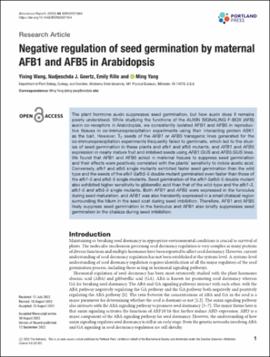| dc.contributor.author | Wang, Yixing | |
| dc.contributor.author | Goertz, Nadjeschda J. | |
| dc.contributor.author | Rillo, Emily | |
| dc.contributor.author | Yang, Ming | |
| dc.date.accessioned | 2023-10-20T14:57:25Z | |
| dc.date.available | 2023-10-20T14:57:25Z | |
| dc.date.issued | 2023-09-12 | |
| dc.identifier | oksd_wang_negative_regulation_of_seed_2022 | |
| dc.identifier.citation | Wang, Y., Goertz, N., Rillo, E., Yang, M. (2023). Negative regulation of seed germination by maternal AFB1 and AFB5 in Arabidopsis. Biosci Rep (2022) 42 (9): BSR20221504. https://doi.org/10.1042/BSR20221504 | |
| dc.identifier.uri | https://hdl.handle.net/11244/339850 | |
| dc.description.abstract | The plant hormone auxin suppresses seed germination, but how auxin does it remains poorly understood. While studying the functions of the AUXIN SIGNALING F-BOX (AFB) auxin co-receptors in Arabidopsis, we consistently isolated AFB1 and AFB5 in reproduc- tive tissues in co-immunoprecipitation experiments using their interacting protein ASK1 as the bait. However, T₂ seeds of the AFB1 or AFB5 transgenic lines generated for the co-immunoprecipitation experiments frequently failed to germinate, which led to the stud- ies of seed germination in these plants and afb1 and afb5 mutants, and AFB1 and AFB5 expression in nearly mature fruit and imbibed seeds using AFB1:GUS and AFB5:GUS lines. We found that AFB1 and AFB5 acted in maternal tissues to suppress seed germination and their effects were positively correlated with the plants’ sensitivity to indole acetic acid. Conversely, afb1 and afb5 single mutants exhibited faster seed germination than the wild type and the seeds of the afb1-5afb5-5 double mutant germinated even faster than those of the afb1-5 and afb5-5 single mutants. Seed germination of the afb1-5afb5-5 double mutant also exhibited higher sensitivity to gibberellic acid than that of the wild-type and the afb1-3, afb1-5 and afb5-5 single mutants. Both AFB1 and AFB5 were expressed in the funiculus during seed maturation, and AFB1 was also transiently expressed in a small chalazal region surrounding the hilum in the seed coat during seed imbibition. Therefore, AFB1 and AFB5 likely suppress seed germination in the funiculus and AFB1 also briefly suppresses seed germination in the chalaza during seed imbibition. | |
| dc.format | application/pdf | |
| dc.rights | This material has been previously published. In the Oklahoma State University Library's institutional repository this version is made available through the open access principles and the terms of agreement/consent between the author(s) and the publisher. The permission policy on the use, reproduction or distribution of the material falls under fair use for educational, scholarship, and research purposes. Contact Digital Resources and Discovery Services at lib-dls@okstate.edu or 405-744-9161 for further information. | |
| dc.title | Negative regulation of seed germination by maternal AFB1 and AFB5 in Arabidopsis | |
| dc.date.updated | 2023-10-17T21:51:17Z | |
| osu.filename | oksd_wang_negative_regulation_of_seed_2022.pdf | |
| dc.identifier.doi | 10.1042/BSR20221504 | |
| dc.description.department | Plant Biology, Ecology and Evolution | |
| dc.type.genre | Article | |
| dc.type.material | Text | |
| dc.subject.keywords | developmental biology | |
| dc.subject.keywords | mutation | |
| dc.subject.keywords | plant biology | |
| dc.subject.keywords | signaling | |
| dc.subject.keywords | auxin sensitivity | |
| dc.subject.keywords | auxin signaling | |
| dc.subject.keywords | chalaza | |
| dc.subject.keywords | funiculus | |
| dc.subject.keywords | maternal effect | |
| dc.subject.keywords | seed dormancy | |
| dc.identifier.author | ORCID: 0000-0002-7499-3338 (Yang, Ming) | |
| dc.identifier.author | ScopusID: 57151591400 (Yang, Ming) | |
